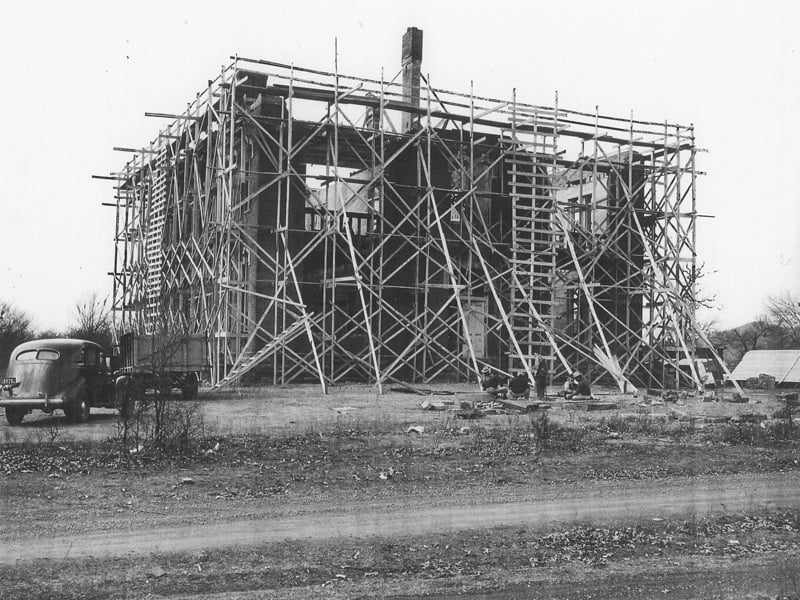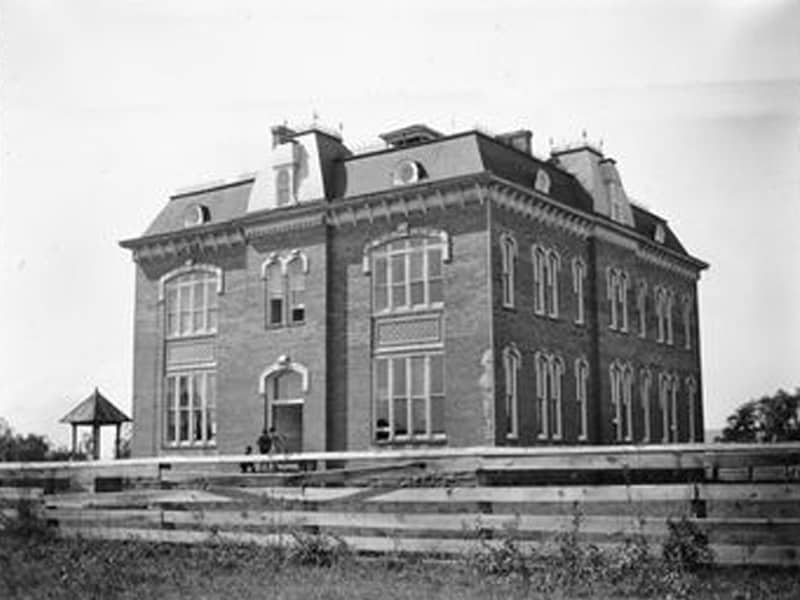
Choctaw Council House, Tvshka Homma Capitol
Architectural History of the Choctaw Nation Capitol at Tuskahoma, 1883-Present
Published June 1, 2023Last month, Iti Fabvssa looked at the architectural history of the Choctaw Nation of Oklahoma’s early capitol buildings at Nvnih Waiya and Armstrong Academy. This month, we would like to continue this journey and look at one of our most beloved landmarks in the Choctaw Nation, the Tvshka Homma Capitol.
In 1879, the Choctaw Tribal Council began plans to construct a more permanent Council House Capitol and allocated construction funding in 1883. An amendment to the Choctaw Constitution read, in part: “The seat of government shall be fixed at or about two and one-half miles east of old Nanih Waiya, and the first and all future sessions of the General Council shall commence on the first Monday of October, 1884, and each and every year thereafter and shall be held at “Tuska Homma’ aforesaid.” Builder H. T. Jackman was hired to the new 11,404 square-foot capitol.
The capitol was set in a small prairie. The building was made from local clay that was fired in large kiln ovens to make the bricks on-site. Because the clay had a high amount of iron oxide, it fired red. The structure they created is three stories high with a mansard roof. The building was designed with ample room for the two branches of the council, executive offices, supreme courtroom, and offices of the different officials of the government and a committee, all furnished and curtained in an elegant manner. The work was all finished since the last council passed the bill moving it from the old Armstrong Academy. The total cost of the capitol building was $25,000, which is equivalent to $754,000 today. In the fall of 1884, editor R. M. Roberts of the Indian Journal at Muskogee wrote, “The capitol building is the finest structure in the Territory and reflects great credit on the building committee and Mr. H.T. Jackman, the contractor.”
The two-story brick edifice was constructed in the similar architectural styles of Italianate and Second Empire. Italianate is an architectural style that draws from 16th-century Italian Renaissance architecture that was popular in the United States from 1840-1880. Italianate-style buildings are typically symmetrical, meaning they have exactly matching windows and features on either side of the central front door. The style features decorative brackets that support overhanging roof eaves and tall round-arch window and door openings with elaborate hood moldings above resembling eyebrows.
The Second Empire style, popular between 1860 and 1890, is a continuation of the Italianate style. The Second Empire style is most often characterized by a two-story projecting wall section around and above the main entrance that is also capped with a mansard roof. At the Capitol Museum, both styles are on glorious display.
The town of Tuskahoma grew around the capitol, with over 100 families and businesses residing there by 1885. Unfortunately, the much-anticipated St. Louis & San Francisco Railroad laid the tracks two miles south, and the townspeople moved their buildings to the new townsite. Remaining at the original location, the Choctaw Capitol building continued to serve the Nation well from 1884 until 1905, when the last Choctaw Council convened. The 1898 Curtis Act dissolved all but a handful of official positions within the Five Tribes, leaving Choctaw Nation with the Principal Chief, Mining Trustee, Tribal Treasurer, and Tribal Attorney who utilized the Capitol building intermittently. Photo 1 shows an image of the original capitol around 1900. In 1934, Choctaw Advisory Council was established, and among their priorities was to preserve the Choctaw Council House. Photo 2 shows the extensive renovation in 1937. The Choctaw Advisory Council shepherded the work and met annually through 1946.
Officially after 1905, the position of Principal Chief was appointed by the U.S. President. However, Choctaw elections continued. Elected by the Choctaw people in 1949, Harry James Watson “Jimmy” Belvin was then appointed by President Truman and served as Principal Chief until 1975. In interviews, Belvin noted he initiated Tvshka Homma’s first Labor Day festivities shortly after his inauguration in 1949. In 1971, Belvin became the first elected Principal Chief to serve without requisite presidential consent in 66 years. In 1978, the Choctaw Nation Council was formed to create a new constitution and fully restore the tribe’s representative government (Milligan 2019: 54). The council met each year for a general assembly at the Choctaw Capitol building and grounds. In a Labor Day address, Chief Belvin noted his accomplishments, including the renovation of the Choctaw Council House and grounds, organizing the Choctaw Nation Historical Society, and establishment of the Choctaw Museum at the Capitol building.

Council House Remodel 1937.

Choctaw Capitol Museum circa 1900-1910.
In 1972, the Tribal Council allocated funding for the restoration of the Choctaw Capitol, hired the firm Day, Davies, and Poe to provide architectural services and contractor B. H. Todd Sons’ Company, Inc. The total cost for the restoration of the first floor was $32,500. That year the Museum adopted its mission statement: “To preserve and promote knowledge and understanding of tribal culture and heritage for Choctaw descendants and the general public.” The Tushkahoma Capitol Museum still operates to fulfill this mission today. In 2002, an elevator was installed to provide accessibility to the second floor. Exhibits about Choctaw history, a gallery of Choctaw art, and an exhibition preparation space are located on the second floor. Access to the attic space is through a narrow staircase.
Today, the Capitol Building continues to serve the Choctaw people as the Choctaw Nation Capitol Museum and Tribal Court House. The Museum is open year-round to the public and features free admission, displays on Choctaw history before European contact, the Trail of Tears, Choctaw life in Oklahoma, the Lighthorsemen, the Choctaw Code Talkers, Choctaw basketry, a gift shop selling Choctaw-made artwork, and much more. Annual events on the ground that bring in large numbers of visitors to the Museum include the Easter Celebration, Veteran’s Day, Trail of Tears Walk, and the Alabama-Tennessee Trail of Tears Corridor Motorcycle Association ride. Each year, the Tushkahoma grounds host the Labor Day Festival with the State of the Nation address, living village demonstrations, a stickball tournament, carnival rides, food trucks, and concerts. Virtually visit the first floor of the Choctaw Capitol Museum and Tribal Court.
Sprinkled in the previous Iti Fabvssa articles are the architectural histories and brief descriptions of the Choctaw capitol buildings in Oklahoma. This history is gathered and archived at the Historic Preservation Department for Choctaw Nation as part of our staff’s mission. Buildings that demonstrate historical significance and look original to their construction may qualify for listing in the National Register of Historic Places. The National Register was created by Congress in 1966 and continues today, along with its sister, the National Historic Landmark program. Tens of thousands of buildings and archeological sites across the United States are listed in the National Register. The National Historic Landmark program tallies approximately 2,500 properties.
In order for a property to be listed, the owner nominates it in a format similar to a high school term paper. The Historic Preservation Department staff assists with research ideas, edits, a building description, maps, and photographs for National Register nominations, both for properties owned by Choctaw Nation and when private owners request assistance with a nomination. Ideally, the owner will present the nomination to the Professional Review Board for consideration. The final listing decision is made by the Keeper of the National Register in Washington, D.C. The Historic Preservation Department is happy to report that the Capitol Museum was listed in 1970, and the National Register nomination was used in writing this article.
For additional information about the National Register, what properties may qualify, and the implications of listing, please contact the Choctaw Historic Preservation Department Architectural Historian Rolene Schliesman at 580-642-2024.